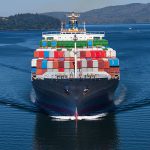The motion of a ship through water requires energy to overcome resistance, i.e. the force working against movement. As the resistance of a full-scale ship cannot be measured directly the knowledge about the resistance of ships comes from model tests. The total resistance on calm water can be divided into three main components: frictional resistance, residual resistance and air resistance.
The frictional resistance depends on the size of the wetted area. It represents often about 70-90% of the ship total resistance for low-speed ships (bulk carriers and tankers), and sometimes less than 40% for high-speed ships (containers and passenger ships). Residual resistance comprises wave resistance that refers to the energy loss caused by waves created by the vessel and viscous pressure resistance. This residual resistance normally represents 10-25% of the total resistance for low-speed ships and up to 40-60% for high-speed ships. Air resistance normally represents about 2% of the total resistance, however, for loaded container ships in head wind, the air resistance can be as much as 10%.
During the operation of ship, the paint film on the hull breaks down. Erosion starts, and marine plants and barnacles, etc. grow on the surface of the hull. In addition, the propeller surface can become rough and foulded. The total resistance caused by fouling may increase by 25-50% throughout the lifetime of a ship.


